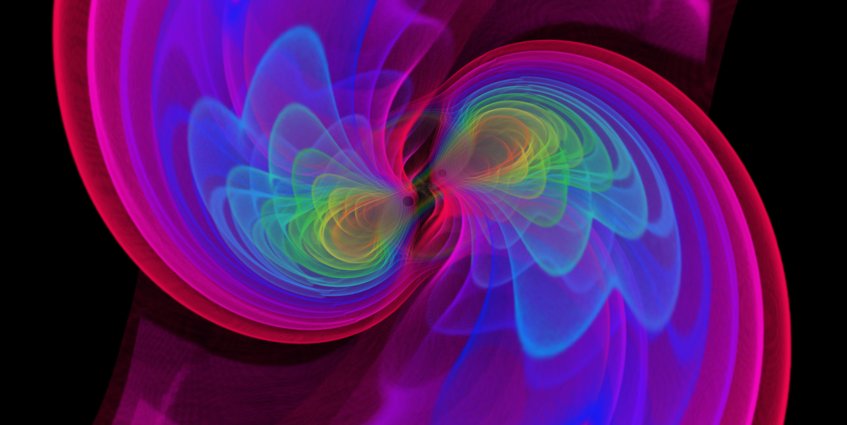
What are gravitational waves?
In 1915, Albert Einstein portrayed a completely new picture of our world in his general theory of relativity: In contrast to Newton's theory, gravitation is not a force, but a consequence of the geometry of space and time. Accelerated motion of large masses leads to ripples in this geometry. These ripples are called gravitational waves and observations of them are now changing how we experience the Universe.
Gravitational waves
Big masses such as stars and galaxies deform space-time around them. If other objects move through such areas, they are diverted from their original path, apparently attracted by the big mass. According to Einstein, what in fact happens is that the objects just follow the path mapped out for them by the deformation of space-time around the big mass.
Accelerated masses give rise to pertubations in the space-time continuum that propagate in all directions at the speed of light. These space-time disturbances are called gravitational waves. They alternately stretch and compress space - so that the distances between the objects in space are changed.
Albert Einstein predicted the existence of these gravitational waves in 1916, but only since the 1990s has technology become powerful enough to permit detecting them and harnessing them for science. The influence of gravitational waves on a binary pulsar system (two neutron stars orbiting each other) has been measured accurately and is in excellent agreement with the predictions. In 1993 R. A. Hulse and J. H. Taylor received the Nobel Prize in Physics for this observation.
Detecting gravitational waves
On September 14, 2015, the first direct detection of gravitational waves from a binary black hole merger has confirmed Einstein’s vision of the waves, and allowed a fascinating and unique view into the dark side of the cosmos. The Nobel Prize in Physics in 2017 was awarded for the first direct detection of gravitational waves.
As of today, more than a 90 direct gravitational-wave detections mostly from merging black hole pairs have been made by the Advanced LIGO and Advanced Virgo detectors. Technology developed and tested at GEO600 was crucial for these observations.
Since 2024, GEO600 is being upgraded to enable gravitational-wave observations at very high frequencies. The detection – but also the non-detection – of high-frequency gravitational waves could shed light on dark matter, exotic physics, and the early Universe.
Listening to the Universe
Gravitational wave astronomy opens an entirely new window on our Universe. Gravitational waves are produced by violent events in the distant universe, for example by the collision of two black holes or neutron stars or by supernova explosions. They are emitted by accelerating masses much in the same way as radio waves are produced by accelerating charges – for example, such as electrons in antennas. These ripples in the space-time fabric travel to Earth, bringing with them information about their violent origins and about the nature of gravity that cannot be obtained by other astronomical tools.
The challenge
However, the changes in distance caused by gravitational waves are tiny: even the gravitational wave produced by a powerful event in our vicinity, like a supernova explosion within the Milky Way, changes the total distance between Earth and Sun only by about the diameter of a hydrogen atom - and that merely for several thousandths of a second. For shorter distances the effect is correspondingly smaller: when measuring over a distance of only one kilometer a change of a thousandths of the diameter of a proton has to be detected to determine the passing of a gravitational wave. This is the effect gravitational-wave detectors measure. The great challenge is to get rid of the many disturbances, such as seismic vibrations of all sorts or even quantum-mechanical effects in the detector, that would conceal a signal.